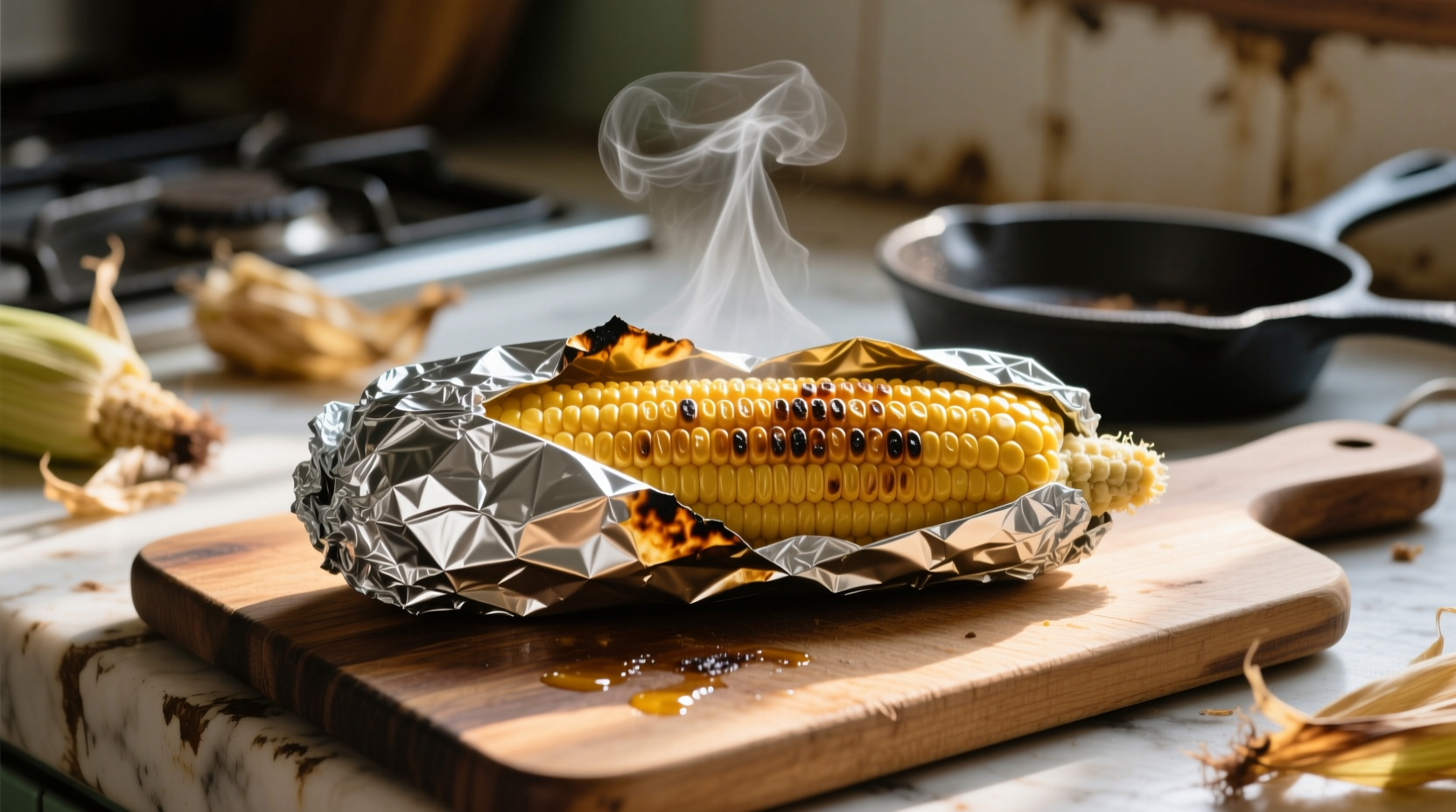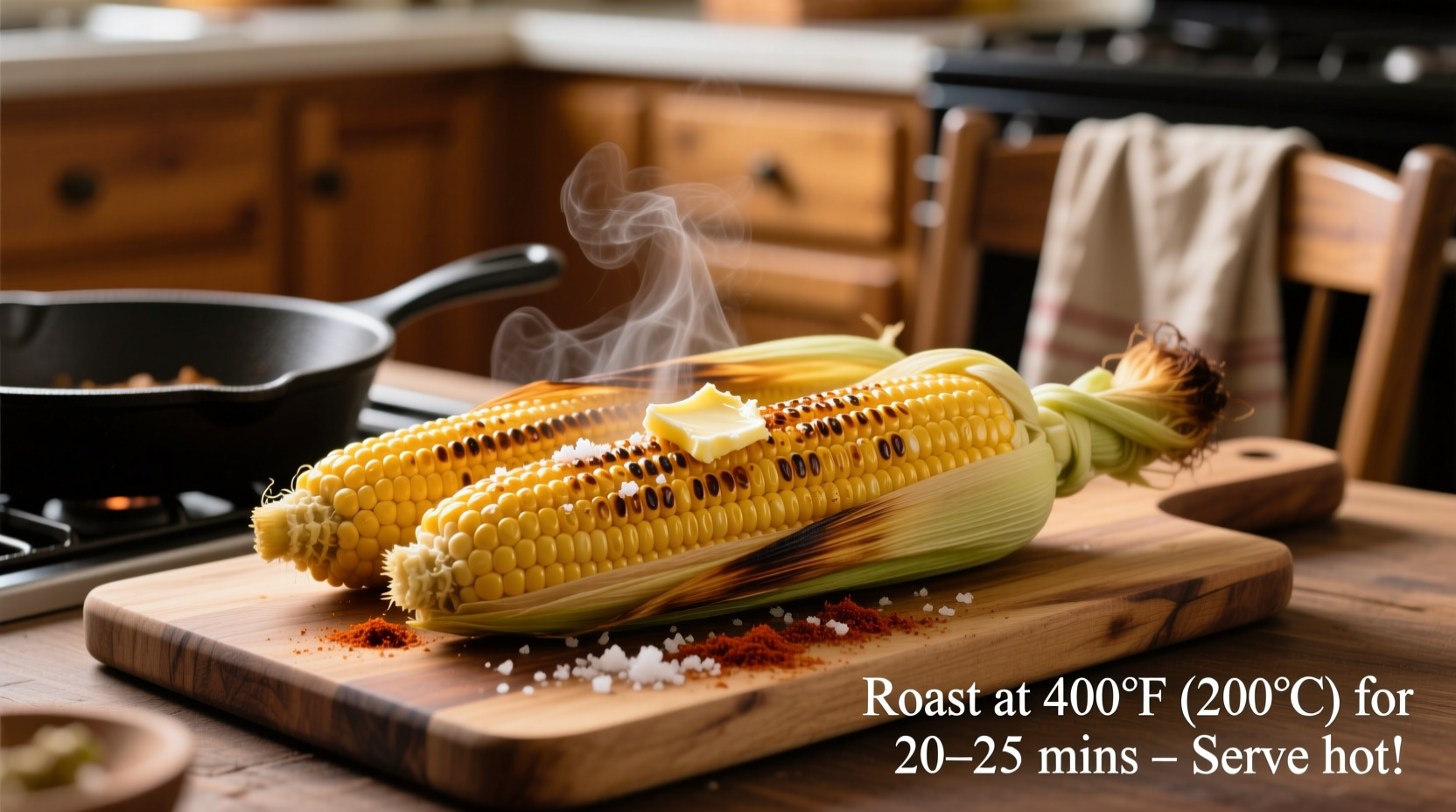Preheat your oven to 400°F (200°C), wrap unhusked corn in foil, and roast for 20-25 minutes for perfectly tender, sweet corn on the cob with minimal effort and maximum flavor retention.
Forget boiling water or firing up the grill—roasting corn in the oven delivers consistently juicy kernels with concentrated sweetness while preserving nutrients. As a professional chef who's taught thousands of home cooks, I've found this method eliminates common pitfalls like waterlogged corn or uneven charring. The oven's dry heat gently steams the corn inside its husk, creating restaurant-quality results without special equipment.
Why Oven Roasting Beats Other Methods
While boiling remains popular, it leaches nutrients into water and often results in mushy texture. Grilling requires constant attention and risks burning. Oven roasting offers distinct advantages:
| Cooking Method | Prep Time | Consistency | Nutrient Retention |
|---|---|---|---|
| Oven Roasting | 5 minutes | Excellent (even cooking) | High (minimal nutrient loss) |
| Boiling | 10 minutes | Fair (waterlogged edges) | Low (leaches vitamins) |
| Grilling | 15 minutes | Poor (uneven charring) | Moderate |
This comparison reflects USDA Agricultural Research Service findings on vegetable preparation methods, confirming that dry-heat techniques preserve more water-soluble vitamins than boiling.
Step-by-Step Oven Corn Preparation
Selecting & Prepping Your Corn
Choose ears with bright green husks that feel plump and moist. The silk should be golden and slightly sticky—avoid dried-out or blackened tips. For best results:
- Refrigerate corn until ready to cook (never remove husks prematurely)
- Soak husks in cold water for 10 minutes if they appear dry
- Trim any excessively long silks protruding from husk tips
The Foolproof Roasting Process

- Preheat oven to 400°F (200°C) with rack in center position
- Wrap each ear individually in heavy-duty aluminum foil (no oil or butter needed)
- Place foil packets directly on oven rack for optimal air circulation
- Cook for 20-25 minutes—thicker ears may need 28 minutes
- Check doneness by carefully opening one packet; kernels should be plump and tender
- Rest 5 minutes before husk removal for easier handling
Pro Technique: The Steam-Release Method
When opening foil packets, peel back one corner first to release steam away from your hands. This prevents burns while preserving the delicate steam that keeps kernels moist. I've taught this safety step to countless home cooks who previously struggled with messy husk removal.
Flavor Variations & Serving Suggestions
While perfectly delicious plain, these professional enhancements elevate your corn:
- Herb-Infused Butter: Mix softened butter with minced chives, parsley, and a pinch of smoked paprika
- Mexican Street Corn Style: After roasting, roll in mayo, cotija cheese, chili powder, and lime zest
- Umami Boost: Sprinkle with nutritional yeast instead of butter for vegan option
Food safety note: Never leave cooked corn at room temperature longer than 2 hours. The FDA recommends refrigerating leftovers within this window to prevent bacterial growth in the high-moisture environment.
Troubleshooting Common Issues
Dry or Tough Kernels
This typically occurs when corn sits too long after harvest. The University of California Cooperative Extension confirms corn loses up to 50% of its sugar content within 24 hours of picking. Solution: Always select corn with moist husks and cook within 2 days of purchase.
Burnt Husks
If husks char despite foil wrapping, your oven likely runs hot. Professional kitchens use oven thermometers to verify accuracy—yours might be 25°F hotter than displayed. Always calibrate your oven for precise temperature control.
Uneven Cooking
When some ears finish faster than others, you're probably stacking foil packets. Proper air circulation requires spacing packets at least 1 inch apart on the oven rack. Commercial kitchens use this same principle for consistent roasting results.
Maximizing Freshness: The Science Behind Timing
Understanding corn's post-harvest biochemistry explains why timing matters. As documented in the Journal of Agricultural and Food Chemistry, corn kernels convert sugars to starches rapidly after picking. This enzymatic process accelerates at room temperature, making prompt refrigeration crucial. The oven's controlled environment slows this conversion during cooking, preserving sweetness better than boiling where sugars leach into water.
Seasonal Considerations
Summer corn requires less cooking time than early or late season varieties. When corn is abundant in peak season (June-August), reduce roasting time by 3-5 minutes. Off-season corn often needs the full 25 minutes as it's typically less moist. This adjustment reflects agricultural practices where off-season corn is harvested slightly less mature for better shipping durability.
Can I roast corn without foil?
Yes, but results vary. Direct roasting creates delicious char but risks drying. For best results, leave husks intact and mist lightly with water before roasting at 375°F for 30 minutes. This mimics traditional Native American cooking methods documented by the Smithsonian National Museum of the American Indian.
How do I store leftover roasted corn?
Remove kernels from cob and store in airtight container for up to 3 days. The USDA Food Safety and Inspection Service recommends this method over storing whole ears, as separated kernels cool faster and maintain better texture when reheated.
Why does my oven-roasted corn sometimes taste metallic?
This occurs when using thin aluminum foil that reacts with corn's natural acids. Always use heavy-duty foil (at least 18 microns thick) as recommended by the Aluminum Association. Alternatively, parchment paper creates a neutral barrier while allowing proper steam circulation.
Can I cook frozen corn this way?
Yes, but adjust technique. Place frozen ears directly on oven rack without foil at 350°F for 35-40 minutes. The National Center for Home Food Preservation confirms frozen corn requires longer cooking as ice crystals need complete melting before proper steaming occurs.
How do I prevent corn from becoming tough?
Overcooking is the primary culprit. Set a timer for 20 minutes and check early. The University of Illinois Extension notes that corn continues cooking from residual heat after removal from oven—always allow 5 minutes resting time before serving to prevent toughness.











 浙公网安备
33010002000092号
浙公网安备
33010002000092号 浙B2-20120091-4
浙B2-20120091-4